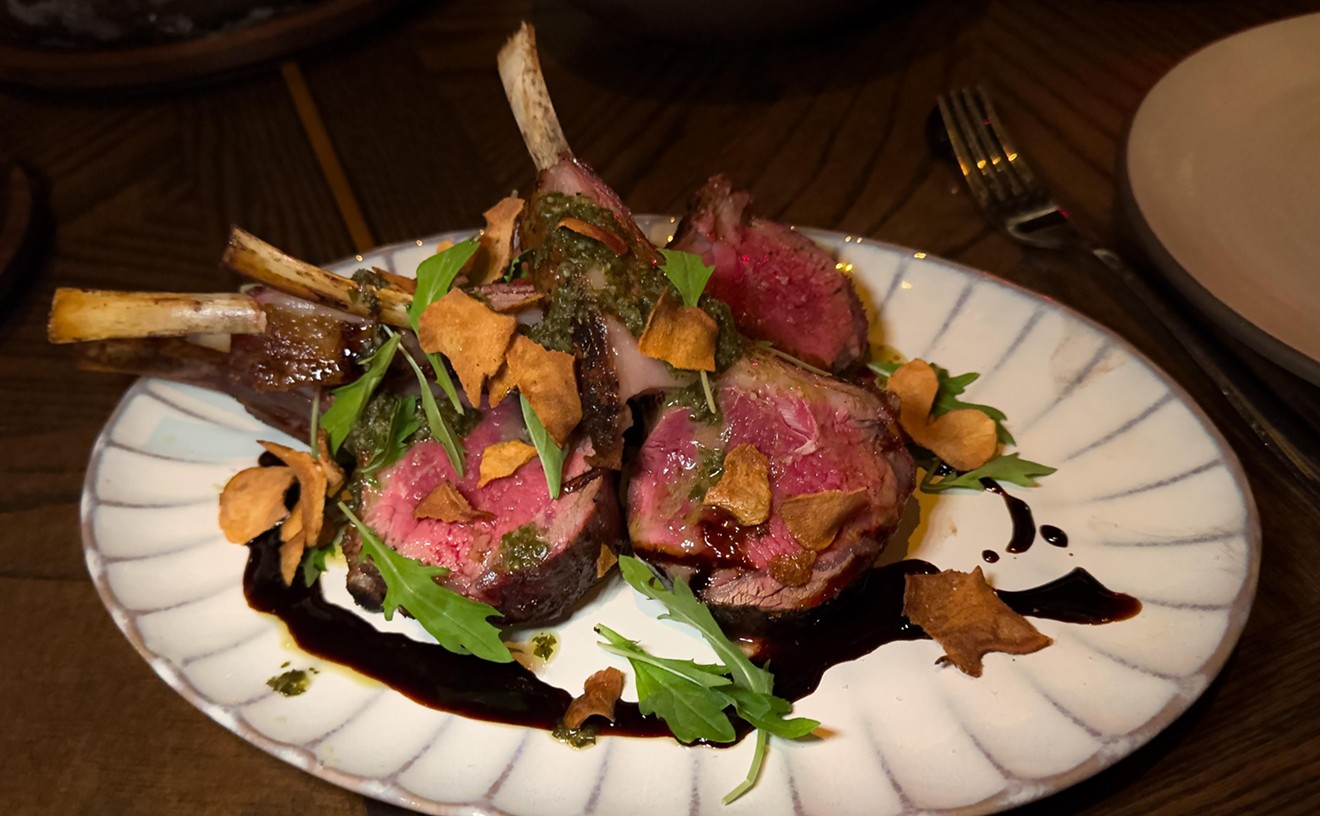If you wait long enough, it will come.
This is my overriding feeling about Phoenix. Case in point: Korean restaurants.
It seemed, for a number of years, that cravings for pickled cabbage or sweet-hot barbecued beef could only be satisfied on the Valley's west side. Phoenix's first Korean restaurant, Korean House, was located at 31st Avenue and Van Buren; its second, Kim Chee House, called 43rd Avenue and Dunlap home.
"Those lucky west siders," I used to think, "they have all the luck."
Then, last summer, Korean Garden boldly went where no Korean restaurant had gone before--Tempe. The move made sense. Poised on the edge of the ASU campus, the pretty, family-style restaurant caught on quickly with students, faculty and adventurous townspeople.
This pioneering effort paved the way for more east-side expansion. Late this spring, Korean Restaurant opened its doors in the remodeled-in-pueblo-style Papago Plaza at North Scottsdale and McDowell Roads. The location alone excited me. Finally, a Seoul-food restaurant in a semicentral spot!
Rest assured, the considerably-more-upscale site is no accident. Okhui and Jinman Lee, the owners of Korean Restaurant, bought Korean House in 1987. In the years that followed, that restaurant suffered a series of misfortunes. Along with A & J Chicago-Style Bar-B-Q, its neighbor in the tiny West Van Buren strip mall, Korean House burned. Twice.
After the second fire in February 1990, Korean House chose not to reopen. Instead, the Lees decided to set up shop across town in Scottsdale. "The schools are better," says Okhui.
And so, like the mythical phoenix, Korean Restaurant has risen from the ashes of Korean House. The new restaurant is a handsome place: spacious and airy and uncluttered. The walls are white, the carpet is turquoise, the white-linened tables are large and surrounded by dark, colonial-style chairs. The look is simple, but inviting. Family is the feeling that comes through loud and strong.
Which makes sense, because Korean Restaurant is a family-run operation. Okhui and Jinman Lee share responsibilities for cooking and managing the restaurant. Daughters Jihyon and Soohyun Lee wait tables. Motherly concern for non-Korean customers is part of the service.
"You sure you want that?" Okhui emerges from the kitchen to warn us about the cold noodle dish we've ordered. "It's very spicy." She scans the menu in her hand. "I help you pick something else. Most Americans don't like it."
Uh oh. RED FLAG. The minute somebody tells me "Americans don't like it," my interest level in that particular food item increases, oh, say, 600 percent. It's a challenge, a dare, and one I can't resist. I thank her, but insist that we really do want the cold noodles.
"Now," Okhui continues, "the beef and noodle soup you ordered is also very spicy. You like spicy food?" We tell her yes. She gives us the once-over in that visual truth-check way moms do, but we're inscrutable. Shaking her head, Okhui returns to the kitchen. She has warned us.
Small dishes of kimchee are placed in the center of the table. We receive five different types: bean sprout, cucumber, spinach, potato and, of course, cabbage. All are excellent. I especially like the spinach and the cucumber varieties--which retain much of the texture of the raw vegetables. Blue cobalt soup bowls matching the salt and pepper shakers are brought and set by each of us. Table settings include forks, chopsticks and long-handled soup spoons. We receive individual, metal-lidded bowls of sticky short-grain rice. We graze on kimchee and steamy hot rice until our main dishes arrive.
In Korea, as in other parts of the Far East, soup is served with the main dishes--not before. Our beef and noodle soup is dried-chile red and filled with shredded beef and a slippery mass of bean noodles. It is hearty without being heavy, and most satisfying. It is spicy enough to make your nose run, but not outrageously so.
We cool our palates with chicken bulkogi. Mildly flavored with sweet Korean barbecue sauce, these charbroiled chunks of chicken may remind you of teriyaki. They are quite tasty when eaten alone with rice, or in combination with one or more kimchee. And then there is our cold noodle dish called mulnaeng myeon. Okhui herself brings it from the kitchen, as some table-side prep is required. She tosses the translucent, threadlike noodles with sweet-hot chile sauce and a handful of ice cubes, then clips them with orange-handled shears. (Now we know how the noodles get cooled and cut.) Other ingredients in the mix include unidentifiable bits of what taste like fish jerky, slivers of zucchini and a halved hard-boiled egg.
And you know what? I like it. I like everything, in fact. My accomplice and I eat continuously for several minutes, talking little, simply savoring the flavors and textures of our meal. Okhui thrusts her head from the kitchen. "I hear sniffing," she accuses. "Too spicy for you?"
"No," we call. "It's fine."
This surprises our hostess. She wrinkles her brow in mock suspicion and puts her hands on her hips. "What kind of food you been eating lately?"
I shrug my shoulders as if to say, "Oh, you know." But inside, I'm thinking: "Whatever it was, it should have been Korean." This is good.
The wait was worth it.
Several years ago, when I lived in west Mesa, I ate quite often at a Chinese restaurant called New Peking. My boyfriend and I went there because it was conveniently located and we found the food and service dependable.
End of story--or so I thought.
Recently, a good friend who still lives in that neighborhood asked me if I'd ever tried the Korean food at New Peking. "New Peking?" I said. "Korean food? Are you sure?"
She assured me she had eaten lunch there not long ago with a Korean acquaintance. "I thought the food was pretty good," she said.
And you know what? She was absolutely right.
Within days, a dining accomplice and I are wending our way to the busy intersection of Dobson and Southern to test out this tip. I find the restaurant looking as inauspicious as ever. The beige interior, the beige tweed booths, the bamboo fans hanging from the lighting fixtures have changed in the same way I have--they've aged.
What is new is New Peking's second, by-request-only Korean menu. To me, anyway. It turns out New Peking has been serving Korean dishes all along. "When did you start serving Korean food?" my accomplice inquires. "Oh, since we opened, seven years ago," our waitress replies. "Finally, we make a menu to help the waiters."
You see, the twenty dishes on this laminated list are not actually Korean dishes. They're more accurately Chinese dishes that are popular in Korea. "If you go to a Chinese restaurant in Korea, they serve these," a friendly gentleman tells us.
"So, they're Chinese," I clarify.
"Yes, in Korea," he says, emphatically.
Well, at any rate, I am very sorry I didn't know about New Peking's "secret" menu sooner. I adore the grilled beef with sliced jalapeno and bell peppers. And I love the match-stick vegetables tossed with shrimp, pork and broad rice noodles in a hot mustard sauce. I even like the sweet and sour beef, which is fried to tempura crispness and coated with a not-pink, not-gloppy sauce.
Our waitress asks us if we'd like kimchee. We, of course, say yes. She brings us cabbage, pickled daikon cubes, cucumber, and sliced daikon. The kimchee is satisfyingly spicy and vinegary, but lacks subtlety. I also miss the little metal bowls of wonderful, short-grain rice routinely served at full-fledged Korean restaurants. The rice here is long-grain and heaped in one dish, Chinese-style. But these are small, niggling points. I love the "Korean menu" at New Peking. Do I like it enough that I'd move back to west Mesa?
Not telling.
Korean Restaurant, 1414 North Scottsdale Road, Scottsdale, 994-5995. Hours: 11 a.m. to 10 p.m., Monday through Saturday; 1 to 9 p.m., Sunday.
New Peking, 1850 West Southern Avenue, Mesa, 834-0909. Hours: Lunch, 11 a.m. to 2:30 p.m., Monday through Friday; Dinner, 4 to 9:30 p.m., Monday through Thursday; 4 to 10 p.m., Friday and Saturday; 11 a.m. to 9:30 p.m., Sunday.
for Korean Restaurant
Finally, a Seoul-food restaurant in a semicentral spot!
The minute somebody tells me "Americans don't like it," my interest level increases, oh, say, 600 percent.
for new peking
"If you go to a Chinese restaurant in Korea, they serve these," a friendly gentleman tells us.










